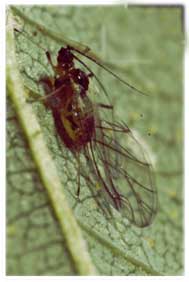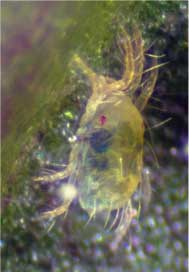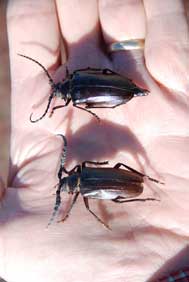What's Bugging Hop & Mint Growers?
Our entomology team is addressing the arthropod pests identified as most problematic by growers of hops and mint. We are studying spider mites, aphids, and California prionus in hops, and spider mites and aphids in mint.
Twospotted Spider Mite, Tetranychus urticae
T. urticae is a pest of both hop and mint, causing damage through its feeding action. It is a serious and perennial threat in virtually all Pacific Northwest hop yards. Infestations of T. urticae can lead to yield and quality losses in hops and may contribute to detrimental flavor characteristics. T. urticae also sucks the juices of mint plants, causing leaves to yellow, bronze, dry, and fall under heavy infestations. Spider mite infestations are known reduce mint oil yield and probably quality.
Results of twospotted spider mite research activity on hops to date.
Results of twospotted spider mite research activity on mint to date.
Hop Aphid, Phorodon humuli
Like T. urticae, P. humuli feeds on hop plant juices and contaminates the cones. Its feeding can lead to yield and quality losses and may contribute to detrimental flavor characteristics. Sooty mold associated with hop aphid honeydew can also contaminate the plant and reduces its photosynthetic area. This may result in loss of the entire crop because affected cones can be rendered unmarketable. P. humuli is a more sporadic pest than T. urticae, favoring the warmer hop-growing areas.
Results of hop aphid research activity to date.
Mint Aphid, Myzus menthae
Infestations of M. menthae are problematic in that they stunt and distort stems and leaves of mint plants, making the plants more susceptible to water stress and decreasing yield. Mint aphids also secrete honeydew, which results in a black, sooty mold and can contribute to leaf sunburn.
California Prionus, Prionus californicus
Larvae of P. californicus can damage hop plants by feeding on their roots. This feeding results in decreased nutrient uptake by the hop plant, water stress, and reduced plant growth. Heavy Prionus infestations can cause wilting, yellowing, and the death of one or more bines or the entire plant. This pest is a major problem in Southern Idaho.
Results of California prionus research to date.
ABOVE: Twospotted spider mite

ABOVE: Hop aphid
ABOVE: Female and male California prionus

